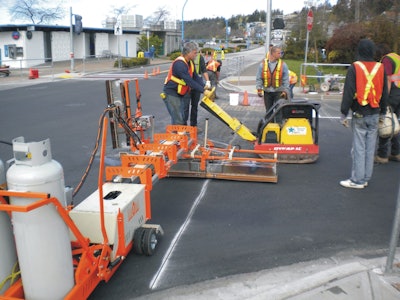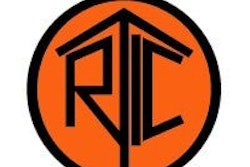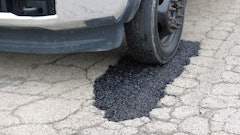
Infrared equipment can provide contractors with countless opportunities to expand their business from repair work to decorative asphalt. But regardless of your infrared use – and regardless whether you’re an experienced operator or just learning the process — once you get your equipment in the field a host of challenges can impact the ease, quality and profitability of your infrared project.
From accessibility to impractical expectations and finishing off the repair these insights, from several infrared equipment manufacturers, will be prepare contractors to handle a host of project issues in the field.
A right tool for the right job
While infrared offers contractors and their customers a number of opportunities to complete repair work successfully the service might not always be the best solution to a pavement problem. Cliff Cameron, KM International, reminds contractors that infrared units aren’t a fix-all application.
“There is a right tool for the right job,” he says. “If you have a base failure you need to correct the base failure, or you need to let your customer know that you can buy them time by using infrared or fix it properly. You could also do the repair with traditional methods and infrared the seams.”
Cameron notes that there are situations where contractors misdiagnose the pavement. “If you look at a heavy alligatored parking lot, sometimes it’s obvious to point right to a base failure,” he says. “What we’re seeing is if you don’t have a base failure that’s where the paver was a little thin with the asphalt so it didn’t handle it structurally; it wasn’t strong enough. If that‘s the case you can go over that, infrared that, and add more asphalt to make it thicker and taper it into the whole repair area.”
Contractors may be eager to take on any project once purchasing their first infrared unit, but Cameron recommends taking a gradual approach to properly learn the equipment and the infrared process. “Once you do infrared, the process itself is so exciting you tend to jump in and want to do more than you’re actually capable of doing,” Cameron says.
Cameron adds that heating the pavement is only part of the infrared process. The other part is compaction of the heated area and he says contractors need to understand the important role compaction can play. He says infrared units are capable of heating and repairing large areas of pavement by heating an area, moving the machine to an adjacent area and heating that while the initial area is compacted and finished. This process enables contractors to repair areas of pavement much larger than the infrared unit itself.
“The machines heat asphalt, that’s what they do,” Cameron says. “But what some guys don’t understand is that when it comes to compaction you can have a lot of undulation (I think) in the finished pavement. You can heat a 6 x 8-foot area here, then do one next to it, next to it, and next to it. It will all be repaired and look good but the end product won’t be optimum.”
Obstacles on the jobsite
Whether it is a steep driveway or a narrow alleyway, accessibility is one challenge contractors encounter when using the equipment. “Accessibility can be a problem depending upon how portable your machine is,” says Greg Larsen, Thermotrack. “You can have problems positioning your equipment if the driveway is steep because you have to get your equipment up the incline, hold it, heat it and get the rest of your equipment up the incline.”
Other aspects of the jobsite contractors should note are the location of gas and electrical lines, and they should make sure there are no flammables in the vicinity of the infrared application.
In order to ensure the best job for the client, Larsen suggests a thorough advance assessment of the area to make sure it is a proper candidate for infrared. “We always say that prep work is more important than the work,” he says. “Contractors should go out and assess whether the job is categorized as easy or difficult. A lot of times when you’re reheating you need to consider the factors of whether you need added equipment, traffic control, or other additional things.”
By evaluating the project contractors can better determine the appropriate pricing for the work making the reheating projects more profitable. “The applicators’ homework should allow them to make the project profitable if they properly analyze the project,” Larsen says.
Challenges with heating the asphalt
Like most applications, infrared can offer great success when properly used, but it can also create challenges if not used properly. Burning the asphalt is one challenge that some contractors encounter if they are not familiar with the equipment.
“Heating the asphalt too much will result in burning the asphalt,” says Dave Strassman, owner of Asphalt Reheat Systems. “Once you heat the asphalt to more than 360°F you start burning the asphalt cement—the glue. This can happen if contractors are trying to heat too deep too fast. You’re trying to heat the top to 360°F, but you are trying to get 2 inches down into the asphalt at about 300°F or more to make it soft and pliable.”
He says the easiest way contractors can prevent burning the asphalt is by watching for smoke. “A little bit of smoke isn’t bad because you will get a certain amount of steam from the water,” Strassman says. “But, if you are sitting there and it is smoking you are definitely burning something.”
He says contractors must remember that when using infrared machines they are responsible for controlling the heat. “If you’re working a patch and it starts to cool off you can just reheat it as long as you haven’t burned the glue,” Strassman says.
But he says a better approach that prevents reheating is “Don’t heat anymore than you can finish. “
“Do you know how long it takes? You have to scrape it up, fix the crack, sometimes you have to do two heats to go down two inches because you don’t want to burn the asphalt,” he says. “You have to expose new glue and you can’t burn it. If it cools off you warm it back up again.”
Strassman says other challenges contractors face is simply knowing the material they will be working on. For example, he says as asphalt ages it is more difficult to work with. “We are out there trying to do infrared repairs on asphalt we don’t know the age of,” he says.
And pavement that has been maintained by the property owner can cause problems as well. “Sometimes the asphalt is sealcoated and we have to burn off the sealcoat to do repairs,” Strassman says.
Working the patch
When doing pavement repairs using infrared the first step after heating is raking the heated material. Wes VanVelsor, owner of Ray-Tech, recommends using a lute with a straight edge that is 30 to 36 inches wide.
And he stresses that the raking technique is important to the finished patch.
He says when raking contractors must remember to maintain the proper distance from the edge of the heated material (where the heated edge meets the sound, unheated pavement). “If you get too close to the heated edge you can have raveling,” VanVelsor says. “When contractors make the break with the rake it should be about 6-inches from the edge.”
He says that a major advantage of conducting repairs using infrared equipment is that infrared units allow contractors to continue operations even in cold weather. “You can make successful patch repairs in winter if you go about it properly,” he says. “In the winter time I would recommend working 9 to 10 inches inside the edge. The cold area is much colder than in the summer time and draws the heat out from that edge so you don’t have the same bonding characteristics as you would in the summer time.”
At some point during the raking process most repairs require some additional asphalt mix. Manufacturers stress it’s essential to carry enough mix with them for the day’s jobs.
“We always recommend having extra propane bottles because with propane you experience bottle freeze,” Cameron says. “If a contractor wants to succeed in this business he teams an infrared unit with a hotbox reclaimer because every repair we come across always needs a couple shovels full of asphalt.”
Strassman says contractors should carry cold patch materials with them for additional asphalt. “Every patch needs a little new asphalt,” he says. “You could use cold asphalt and heat it with the heater. You can carry it in the back of your truck and throw it under the heater when needed.”
After mix is added (along with an asphalt rejuvenator when needed) the repair must be compacted. Manufacturers say the most common compaction tool for smaller repairs, which most contractors already own, is a walk-behind vibrating plate. This can be enough to provide proper compaction but many contractors prefer to rely on their small rollers.
Manufacturers say that whichever equipment is used it’s important to compact the repair from the outside moving in, essentially pinching the edges where the heated pavement meets the cold pavement. This provides a better bond and can help seal the edges. It also helps create a smoother transition from the cold pavement to the repaired area.
VanVelsor adds that rollers and plates aren’t the only tools contractors should have on their trailer. “To get good compaction around a manhole or other hard-to-reach areas contractors should use a hand tamp. It’s amazing how much compaction you can get from a hand tamp.”
Overall, because infrared equipment can be used to solve a broad variety of pavement issues contractors should advance slowly but steadily into the infrared pavement repair service. “It’s important to take it gradually, understand what you’re doing and do what you can do effectively for your experience level,” he says. “Don’t be afraid to consult with the person that sold your machine.”




















